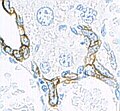Keratin: Difference between revisions
CSV import |
CSV import |
||
| Line 27: | Line 27: | ||
{{stub}} | {{stub}} | ||
{{dictionary-stub1}} | {{dictionary-stub1}} | ||
<gallery> | |||
File:KeratinF9.png|Keratin | |||
File:Male_impala_profile.jpg|Male impala profile | |||
File:Chromosome_12.svg|Chromosome 12 | |||
File:Chromosome_17.svg|Chromosome 17 | |||
File:Human_Keratins_1-8_Protein_Alignment_Rod_Domain.tif|Human Keratins 1-8 Protein Alignment Rod Domain | |||
File:Keratin.jpg|Keratin | |||
File:Toe_nail.jpg|Toe nail | |||
</gallery> | |||
Latest revision as of 11:13, 18 February 2025
Keratin is a type of protein that is a key structural material in the human body. It is found in the epidermis, hair, nails, and other parts of the body. Keratin also provides necessary strength and resilience to these tissues.
Structure[edit]
Keratin is a fibrous structural protein, meaning it is made up of amino acids that form a long chain. These chains form a helix shape, which is then organized into a higher-level structure known as a filament. The specific arrangement of these filaments gives keratin its unique properties.
Types[edit]
There are two main types of keratin: alpha-keratin and beta-keratin. Alpha-keratin is found in mammals and forms a right-handed coiled coil structure. Beta-keratin, found in birds and reptiles, is formed by pleated sheets.
Functions[edit]
Keratin serves several important functions in the body. It provides structural integrity to cells, protects against damage, and aids in the formation of hair and nails. In addition, keratin can also have antimicrobial properties.
Clinical significance[edit]
Abnormalities in keratin can lead to a variety of diseases, including epidermolysis bullosa simplex, ichthyosis, and pachyonychia congenita. These diseases are often characterized by skin blistering, nail dystrophy, and other symptoms.









